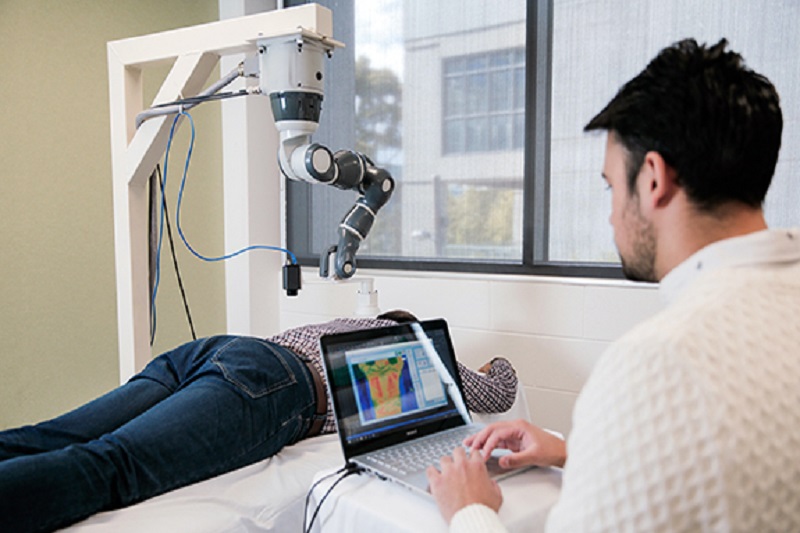
Researchers from Australia’s Swinburne University of Technology have developed a collaborative robot system that automatically treats back, neck and head pain caused by soft tissue injury.
As reported, the system uses a collaborative robot to apply targeted laser therapy to identified pain ‘hot spots’ that were determined through the analysis of a patient by a thermal camera.
A Senior Lecturer at the University, who led the project, explained that collaborative robots are designed to work alongside people, unlike the conventional industrial robots that operate in a cage.
Collaborative robots are power and speed limited so they can collide with people without causing harm.
How does it work?
The focus of the project, which is in conjunction with an industry partner, was to develop an automatic solution for safe robotic examination and treatment of patients with chronic pain.
Using the same technology used in cricket to show whether the ball has made contact with the bat, a thermal camera scans the patient and locates injuries and inflammation by identifying hot spots in a thermal image.
The location of the hot spot is then sent to the collaborative robot that moves a low-level infrared laser into contact with the patient to perform treatment.
The project has delivered a fully working prototype for automated photobiomodulation (PBM) therapy for chronic pain.
This is a form of therapy that applies low-level lasers or light emitting diodes to the surface of the body to stimulate and heal soft tissue.
The Co-Founder of the industry partner, which is one of the Australian pioneers of PBM therapy, shared that studies have shown PBM therapy to have positive effects on chronic pain symptoms.
Introducing collaborative robots to deliver treatment has the potential to improve the precision of the therapy in addition to reducing costs involved.
Industry 4.0 and the future of work
Building on Industry 4.0 technologies and big data analysis, the derived platform can self-adapt to provide individually optimal treatment.
In relation to Industry 4.0, the University’s Centre for New Workforce has released a report on the future of work.
According to the press release, the report is based on a national survey of 1,000 working Australians – from CEOs to bus drivers, full-time and freelance workers.
Digital disruption of the workplace will compel a radical reinvention of how workers are educated and trained for the future of work.
Titled ‘Peak Human Potential – Preparing Australia’s workforce for the digital future’, the report states that workers recognise the need to capitalise on their human qualities to avoid being displaced by technology.
Learning on the job
Findings showed that to prepare to work in digital environments, Australian workers prefer learning on the job. The more digitally disrupted their industry, the more workers prefer to learn at work.
Digital disruption of work is taking place in the workplace, not in the classroom. Thus, a new approach called ‘learning-integrated work’ is being proposed.
This approach immerses students and workers alike in disrupted work environments.
The workers should, first, be lifted into the digital economy by providing them basic digital training.
After which, learning should be shifted into future workplaces by trialling new learning partnerships between education institutions and employers.
All students and all workers need to have future work skills. To build a workforce for the future of work, more integration is needed between Vocational Education and Training (VET) and higher education sectors.
This new approach to the future of work needs to be supported by an innovative learning infrastructure that puts people at the centre.
People responsible
Only the government has the resources to support digital training of all workers, and the policy levers to coordinate and network this new learning infrastructure of educator-employer partnerships across the economy.
Government funding for basic digital competency should be tied to the individual worker to learn at work, catalysing these partnerships.
But it is equally incumbent on educators and employers to develop new learning partnerships that focus on preparing people for the digital future.
















